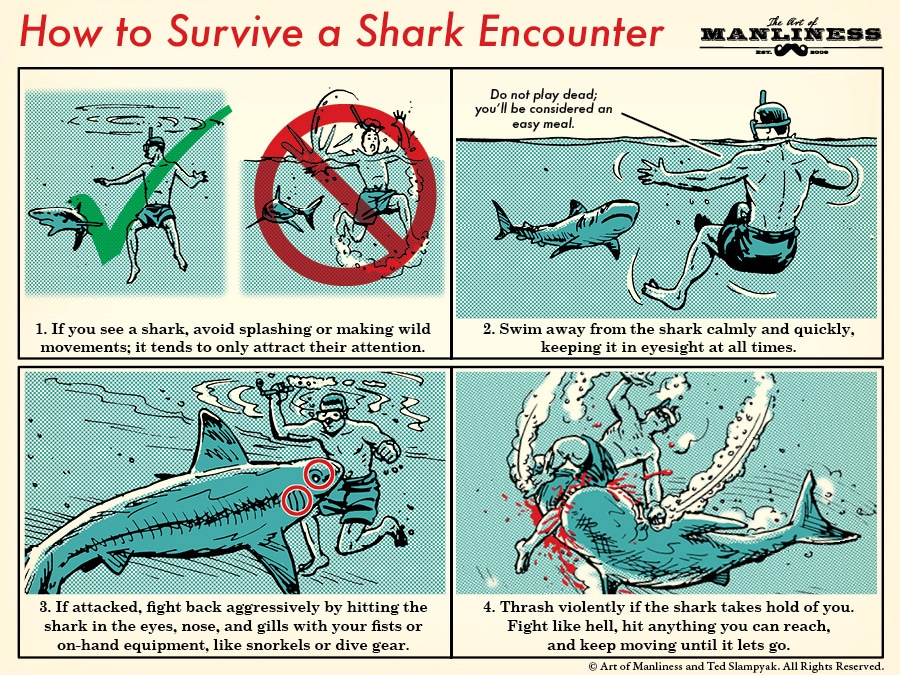
Ahhhh…. life couldn’t be better. You’re finally on that vacation in the Florida Keys that you’ve been planning for the past year. And it couldn’t have come any sooner. Things were getting crazy at the office.
Duh-da…
You’re relaxing on a rubber raft that’s floating about 50 yards from shore while you let the sun rays wash all your cares away.
Duh-da…
You decide to head back to the resort to challenge your wife to a game of volleyball, but then you see something swimming towards you underwater…
Duh-da duh-da duh-da duh-da
HOLY CRAP! IT’S A FREAKING SHARK!!!!!
You start to wish you were back at the office.

Sharks are scary. Way scary. Thanks to Jaws and Shark Week on the Discovery Channel, anytime I step foot in the ocean, I’m always on the lookout for sharks. It also doesn’t help that anytime there’s a shark attack in the U.S., the media covers it for weeks. All the coverage can give a person the idea that sharks are swimming around shores across the world just waiting for you to get in the water so they can tear you to shreds.
The reality is that shark attacks are a rare event and my fear is completely irrational. We humans probably kill more sharks every year than sharks have killed humans in the history of the world. Back in 2000 (the year with the most recorded shark attacks) there were only 79 attacks worldwide. 79. To put things in perspective, you have a better chance of being struck by lightning and dying than you do of getting attacked by a shark.
But there’s always that chance you’ll one day run into a shark. Just ask Bethany Hamilton. Or any of these people. In that rare event, it’s always good to be prepared. Here’s what to do in order to face a shark and live to tell about it.
Where Do Most Shark Attacks Occur?
According to the International Shark Attack File, the majority of shark attacks in the world occur in the United States. The states with the most attacks are Florida, Hawaii, California, South Carolina, and North Carolina. Outside of the U.S., Australia and South Africa have had the most attacks.
So let’s say you’re in one of these geographic areas for a day at the beach. Which parts of the water should you avoid? Well, sharks usually feed in areas with steep drop-offs or in between sandbars. If you swim around these areas, you’re likely to bump into a hungry shark who might think you look like one of the sea lions he’s devouring for dinner. So, it’s probably a good idea to avoid these areas.
What Types of Sharks Attack Humans?
While over 360 different shark species exist, only 20 species are known to attack humans. Of those 20 species, only four have been involved in a significant number of fatal, unprovoked attacks on humans. The first step of beating your enemy is knowing your enemy. Let’s take a look at these four man-eaters so you know what to scout for the next time you’re out in the water.
The Great White

Thanks to Jaws, the great white is the most infamous of all the man-eating sharks. They live primarily in coastal areas, particularly along the shores of Australia, California, and the Northwestern U.S. The great white is the world’s largest predatory fish. This behemoth can reach lengths of 20 feet and and weigh up to 5,000 pounds. 5,000 pounds! In addition to its size, the great white has a large conical snout that distinguishes it from other sharks.
Tiger Shark

Tiger sharks live close to shore in tropical and sub-tropical waters. When they’re young, tiger sharks have spots or stripes much like a tiger, hence the name. Tiger sharks are a killing machine. They can reach speeds of 20 mph and can sometimes go faster if they’re really hungry. Their teeth are designed to slice through flesh, bone, and even turtle shells like a Ginsu knife cutting through a tomato. One of the tiger shark’s secret weapons is a series of pits on the side of its body that hold electrical sensors. Most sharks have these, but they’re particularly sensitive in tiger sharks. These little sensors detect the electro-magnetic fields of other organisms, allowing the tiger shark to hunt its prey without even seeing them. Yeah, tiger sharks can kill you even if it’s pitch black in the water. Sort of like the Predator.
Bull Shark

The bull shark likes to hang out in warm, shallow waters along coasts. Unlike the other sharks on this list, the bull shark can tolerate fresh water, so they’ll even work their way up into rivers every now and then just for the heck of it. Some have even made it all the way to St. Louis, MO via the Mississippi River. Consequently, these bad boys are responsible for most of the near-shore attacks on humans.
Bull sharks have a gray top and a white bottom. They’re wide, sort of like a bull, but they don’t get as big as the great white. Males usually reach lengths of 6 feet. Females can reach lengths of 13 feet.
Oceanic Whitetip Shark

These suckers have attacked more humans than all the other species combined. The oceanic whitetip shark spends most of its time in deeper waters, but will come to shallower waters every now and then. Because it spends most of its time in deeper waters, scuba divers and people involved in boating accidents tend to be its main victims. Its distinguishing characteristics are its long wing-like pectoral and dorsal fins.
Types of Shark Attacks

There are two types shark attacks: provoked and unprovoked. Provoked attacks occur when the human touches the shark first. These usually happen when some knucklehead scuba diver tries to feed a shark or grab its tail on a dare. If you’re dumb enough to grab a shark by its tail, you deserve whatever you get. Sorry.
Unprovoked attacks happen when you’re just chilling on your surfboard and a shark swims up, bites your leg, and pulls you down into the water Jaws-style. Why do sharks attack humans? It’s probably not for food. Humans don’t make a good meal for sharks because we don’t have the fat that sharks need to power their huge, scary bodies. It’s more likely the shark is just figuring out what you are. Unlike most animals that check things out by looking at the object or smelling it, sharks just bite the hell out of whatever they’re exploring. It’s messy, but it gets the job done.
In the area of unprovoked shark attacks, scientists have observed three different kinds: the hit and run, the bump and bite, and the sneak attack.
The Hit and Run. This is the most common type of attack. It occurs in surf zones where swimmers and surfers are easy targets. The victim usually doesn’t see the shark before he feels its teeth sinking into his flesh. After sneaking up on the victim like a ninja, the shark will take one bite and then swim off, never returning.
Why do sharks do this? Because they can. That’s why. But seriously, he was probably just curious about what you were and wanted to find out by taking a chunk of your leg. After sampling your bad tasting meat, he decided to find lunch somewhere else.
Your chances of surviving a hit and run attack are pretty good, barring the shark hitting any vital organs with his bite and if you get medical attention immediately.
Bump and Bite. Unlike the hit and run, the victim will often see the shark before it attacks. The shark will start off by circling its potential victim and giving him a few bumps with its snout. You know. To mess with you.
After sufficiently scaring the crap out of you, the shark will start biting you. Repeatedly.
Bump and bite attacks result in severe injuries or fatalities. They usually occur in deeper waters, but can sometimes occur near shore.
Sneak Attacks. Sneak attacks are sort of like the hit and run — the victim usually can’t see the shark before the attack. But unlike the hit and run attack, where the shark will take a gnaw of your arm and then swim off, in sneak attacks the shark will bite repeatedly. Usually until you die.
Preventing Shark Attacks
The best way to survive a shark attack is to avoid one in the first place. Just follow these guidelines so your foot doesn’t end up in the stomach of a tiburon.
Do not enter the water if sharks are known to be present and evacuate the water if sharks are seen while you’re there. Beaches will often post warnings to avoid swimming because sharks have been spotted in the area. You’d think people would heed these warnings, but several attacks have occurred when individuals ignored these warnings and went swimming anyway.
Stay in groups. Sharks are more likely to pick off lone individuals.
Don’t wander too far from shore. If you’re in an area that’s a habitat for sharks, stay close to shore. Of course, if bull sharks are in the area, you’re screwed because those devils love shallow water.
Avoid water during darkness or twilight hours. Sharks are most active at these times.
Don’t enter the water if you’re bleeding. You’re basically telling sharks, “Hey, over here! Eat me!” Sharks have a powerful sense of smell. Just one whiff of your blood, and they’ll be on you faster than you can say Jack Robinson.
Don’t pee in the water. We’ve all done it. 1) We’re too lazy to get out of the water to go to the bathroom and 2) it kind feels good to pee while sitting in a body of water. But if you’re in an area where sharks are prevalent, better to hold your pee until you can make it ashore. Sharks might pick up on the scent of your fragrant urine and swim over to check things out.
Avoid steep drop-offs and waters in between sandbars. We covered this bit above.
Avoid shiny jewelry and bright clothing. Sharks have a pretty good sense of sight. They can see contrasts especially well. Shiny jewelry and bright clothing provide a nice contrast to the dark water of the ocean, making you a very visible target. If Mr. T one day decides to go surfing, he’s a dead man.
Avoid waters being used by sport or commercial fisherman. Fisherman leave a lot of scraps and bait in the water. Other fish come to nibble on the leftovers, creating a huge mass of potential shark food. These areas essentially become Shark Golden Corral. Don’t put yourself on the buffet menu by swimming in these areas.
Fending Off a Shark Attack

A pile driver is always an effective method of fending off a shark attack.
So you’ve done all you can to prevent a shark attack, but today just isn’t your day. How do you fend off an attacking shark and come out alive? Here’s how to do it:
Reduce the shark’s possible angles of attack. If you’re lucky enough to see the shark before it attacks you, increase your chances of survival by backing up against a reef or rock pile. That way you only have to fend off attacks in front of you instead of having to fend off attacks from 360 degrees.
Hit him where it hurts. Your best chance of fending off a shark attack is pummeling a shark in its most sensitive areas. The shark’s nards aren’t it (they are on a wolfman, though). Instead aim for the eyes and gills. The nose is also a sensitive spot on a shark, but not as sensitive as the eyes and the gills. Also, you risk injuring your hand when you aim for the nose because you might miss it and glance your hand off the shark’s razor sharp teeth.
Use a weapon. Use anything at your disposal for a weapon — goggles, camera, rocks, sticks, etc. Some experts recommend that divers who will be in shark infested waters carry a shark “billy.” It’s just a three foot stick with a sharpened point. When a shark gets a little too close for comfort, you can give a few quick jabs to the gills to scare the shark off. If you don’t have any weapons, just use your hands… like a man.
Use sharp, quick, and repeated jabs. Whether you’re using your bare fists or some sort of weapon, make sure to make quick, straight jabs. If you swing your arm like you’re trying to deliver an overhand punch, you’ll only create drag and slow your arm down.
Never give-up, never surrender. Keep pummeling the shark’s eyes and gills until you either die or the shark goes away. If you create enough trouble for the shark, he’ll eventually give up and find something easier to eat.
Get out of the water and get help immediately. Whew. The bastard is gone and you’re still alive. But you’re probably in bad shape. Really bad shape. You’re likely bleeding something horrible which only creates a scent to attract more sharks. Get out of the water as fast as you can. Once out, seek medical care ASAP.
Develop an awesome bar story. On your trip to the hospital, start coming up with the story you’re going to tell the folks at the bar. No one will ever be able to top this tale.


